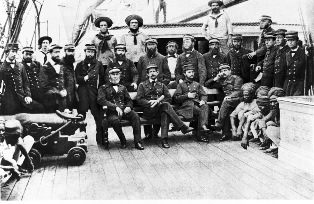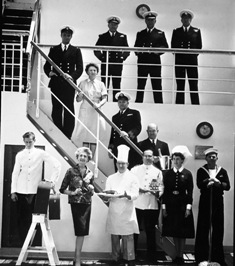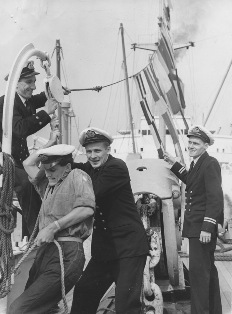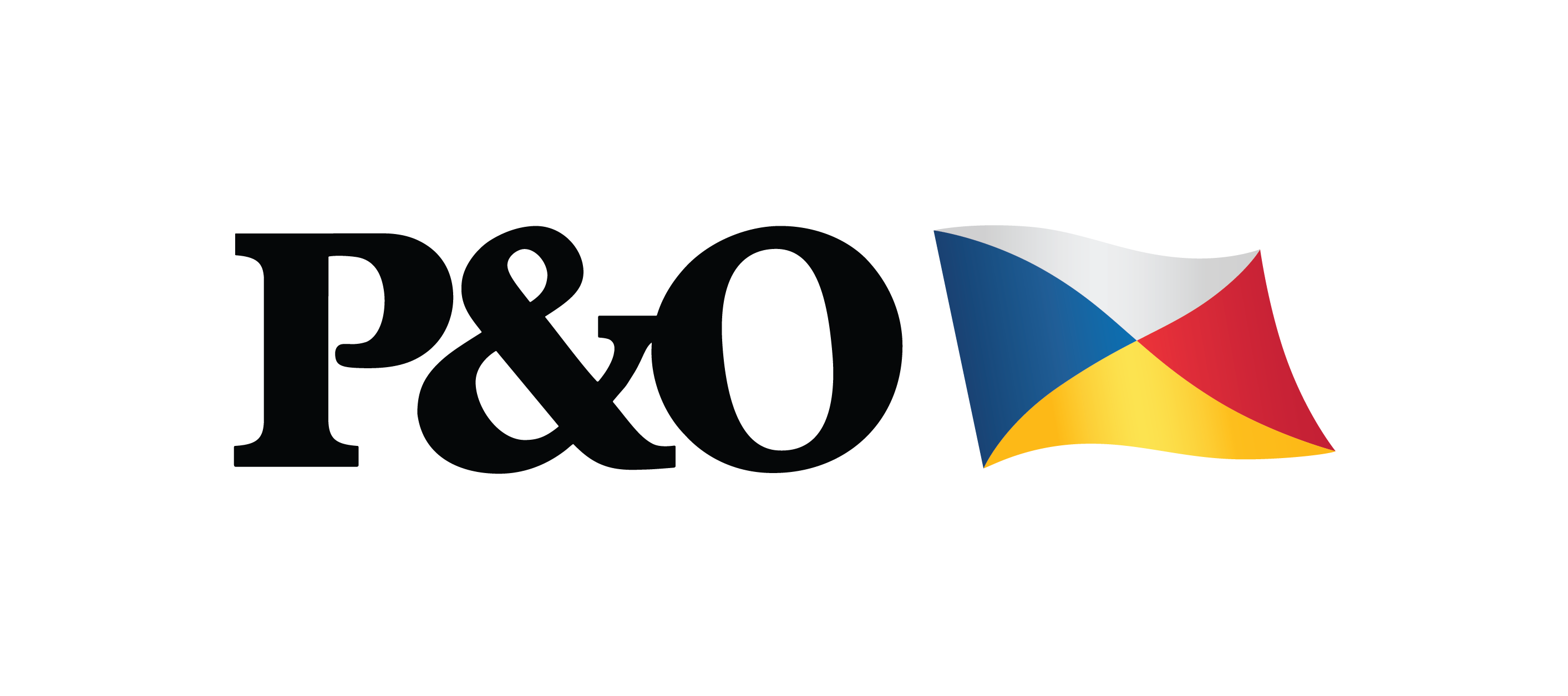Crew Agreements, Lists and Official Logs
Introduction
Agreements and Crew Lists were introduced into the British merchant service when The Merchant Shipping Act of 1835 required each ship to complete them as well as other related documents. They were then filed with the Register Office of Merchant Seamen (now the Registrar General of Shipping and Seamen). The agreements were used by the ship's master (Captain) to record the conditions of employment for the crew on a per voyage basis and to outline their period of service. Each agreement was then signed or marked by the individual seaman before the ship sailed. The resultant crew lists were used by the Board of Trade registry clerks to create entries in the various seamen's registers (See Merchant Seamen General Research Guide).
Crew Agreements for each merchant ship generally list:
- A description of the ship and it's owners
- Name of the ship's Master
- Port of commencement of the voyage in question
- Destination and/or port of termination of the voyage
- Daily meal provisions for the crew
- Rules or laws to be observed during the voyage
- Particulars for each member of the crew, including name (signature), age, place of birth, previous ship, place and date of signing, capacity (seaman, fireman, engineer, etc), Certificate of Competency number (if any), when expected on board, pay for the journey, and address details
- Particulars of discharge (end of voyage, desertion, sickness, death, never joined etc)
- Ports visited (endorsements by British Consuls)
Pre-1835
 No systematic record of crew belonging to merchant ships was kept until 1747. Until that date, the researcher must rely upon the chance survival of material amongst records kept for other purposes, especially State Papers and those of the Colonial Office, the Treasury, High Court of Admiralty and High Court of Delegates. Most of these records are not indexed in a way which would assist a search for a specific ship or seaman.
No systematic record of crew belonging to merchant ships was kept until 1747. Until that date, the researcher must rely upon the chance survival of material amongst records kept for other purposes, especially State Papers and those of the Colonial Office, the Treasury, High Court of Admiralty and High Court of Delegates. Most of these records are not indexed in a way which would assist a search for a specific ship or seaman.
From 1747, masters or owners of merchant ships were required to keep and file a Muster Roll, giving details of the number of crewmen and the ship's voyages. These lists, which were kept as a result of the Act for the Relief of Disabled Seamen 1747, were filed with the Seamen's Fund Receivers at the ports of arrival. The musters are found at The National Archives, Kew, in series BT 98, piece numbers 1-139. They cover a number of ports and various dates from 1747 to 1853.
There is no index to the ships' or crews' names in BT 98, and they are arranged by year and port of filing. Sometimes they include a full list of the crew's names, but more commonly they name only the owner and Master and give the number of crew members. The early lists are more likely to show the crews’ names and against each name details of the amount of money to be invested in the fund.
1835 - 1860
Following the 1835 Merchant Shipping Act, Crew Lists and other documents up to 1860 form part of series BT 98 (Agreements and Crew List) at The National Archives. Before 1861 all official copies are to be found at The National Archives and can be broken down as follows:
1835-1844
During this period two main types of Crew List are to be found.
- Schedule C, Crew List (Foreign), was made by the Master of each ship undertaking a foreign voyage, and was to be filed within 48 hours of the ship's return to a UK port. The term 'Foreign Going Ship' means 'every ship employed in trading or going between some place or places in the United Kingdom and some place or places situate beyond the following limits, the Coasts of the United Kingdom, the Islands of Guernsey, Jersey, Sark, Alderney and Man and the Continent of Europe between the River Elbe and Brest inclusive'.
- Schedule D, Account of Voyages and Crew for Home Trade Ship (Half Yearly Return), was made by the Master of a ship engaged in the coastal or fishing trade, giving the voyages and crew for the preceding half year, and was to be filed within 21 days of the end of June or December. These two types of list contain similar information, but an appreciation of the different filing rules will assist in understanding the entries to be found in the various seamen's registers.
The Crew Lists for the whole period 1835-1844 are filed by ship's Port of Registry; for each port the lists are grouped into boxes by the initial letter of ships' names, but within each box the lists are randomly arranged. At this date, the Crew List will give brief details about the ship, its Master and voyages together with, for each crew member:
- First and Surnames
- Age
- Place of birth
- Rank/duty
- Ship in which last served
- Date and place of joining ship
- Time and place of death or leaving ship
1845-1856
From 1845 onwards further types of list were introduced, and three key ones are found in addition to the Schedules C and D already mentioned. Schedules A, B, C and D all give information which is very similar to that quoted above.
- Schedule A, Agreement for Foreign Trade, (commonly called 'Articles') was an agreement between Master and crew, and was to be filed within 24 hours of the ship's return to a UK port.
- Schedule B, Agreement for Home Trade, was the equivalent for the coastal and fishing trade and was to be filed within 30 days of the end of June or December.
- Schedule G, Names and Register Tickets of Crew (Foreign Trade), was a list of crew, with their Register Ticket numbers, to be filed for a foreign-going ship on sailing.
For this period the Crew Lists are arranged in BT 98 by the year, the port of registry and are then grouped into boxes according to the initial letter of the ship's name. To locate the crew list of a ship on which an individual seaman sailed, it is necessary to determine its name - this is not given in the registers of seamen's service until 1854. A search of all the available crew lists is only practical for small ports.
1857-1860
From 1857 onwards, the records are arranged in BT 98 by ships' Official Number (ON). The ON was allocated on registration and was retained for the life of the ship (even if the ship was renamed) or until it left the British register, and was not reused. ONs may be found from the Mercantile Navy List or Lloyds Register, copies of which are available at The National Archives.
1861 - 1938 and 1950 - 1989
Unfortunately the majority of crew agreements that exist for these periods are scattered amongst a number of repositories both in the UK and abroad. A 10% specimen group of crew agreements for each year, taken at random (every tenth box of papers) together with those for famous vessels (with some exceptions, such as those for the Cutty Sark and SS Great Britain), are in The National Archives series BT 99 for the periods 1861 to 1938 and again from 1950 to 1989. For the period 1861 to 1923, they can be searched for on The National Archives catalogue using the ship's Official Number (ON) which is obtainable from the Mercantile Navy Lists. After that date, the Catalogue gives ranges of ship's Official Numbers.
The remaining 90% for 1861, 1862, and for years ending in '5' from 1865 until 1935 and 1955 up until 1975, are held by the National Maritime Museum, Greenwich.
Local and Regional Record Offices hold some Agreements for the period 1863-1913 (see the next page for a list).
The rest, approximately 70% of the Agreements and Crew Lists for 1863 to 1938 and 1951 to 1976, were transferred to the Maritime History Archive, Memorial University at St John's, Newfoundland, Canada.
After 1972 only the two 10% samples of Agreements and Crew Lists held by The National Archives and by the National Maritime Museum have been preserved. The rest of the Agreements and Crew Lists, up to 1989, have been destroyed. The Registry of Shipping and Seamen hold all Agreements and Crew Lists from 1999.
 1939 - 1950
1939 - 1950
The National Archives holds the surviving official Agreements and Crew Lists for the Second World War and the succeeding years up to 1950. These can be found in various record series and can be searched for by the ships' Official Numbers in the Catalogue.
Series Records:
- BT 99 Registrar General of Shipping and Seamen and predecessor: Agreements and Crew Lists, Series II 1939-1950
- BT 100 Registrar General of Shipping and Seamen and predecessor: Agreements and Crew Lists, Series III (Celebrated Ships) 1939-1950
- BT 385 Registrar General of Shipping and Seamen: Index to WWII Ships' Log Books and Agreements and Crew Lists 1939-1950
- BT 380 Registrar General of Shipping and Seamen: WWII Log Books, Agreements and Crew Lists and associated records 1939-1950
- BT 381 Registry of Shipping and Seamen: WWII Coast Trade Official Log Books and Crew Agreements 1939-1945
- BT 387 Registrar General of Shipping and Seamen: WWII Log Books and Agreements and Crew Lists of allied foreign ships requisitioned or chartered by HMG 1939-1946
- 1 of 4




